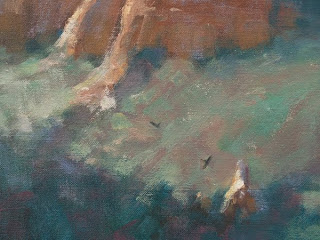The other day I wrote about saving a painting by cropping with a bandsaw and other desperate means. Sometimes, a painting is "close" and just needs a few tweaks. I had a painting like that, a 12x16 oil that I knew immediately upon getting home that it needed adjustment.
I was with a student over near Bell Rock, a popular vortex destination for tourists. Normally, I would avoid a spot that has the potential for high curiosity traffic, but it was early in the morning, and we had gotten some good, strong coffee and were feeling bullish. Because the parking lot was virtually empty, we set up there. We had a great view of some rim-lit rocks. In the process of trying to make the shadowed trees below the rocks "read" as shadowed and the sunlit trees "read" as sunlit, I made the sunlit trees too bright in value. The painting looked fine in the field, and as the parking lot filled to capacity, a number of tourists told me so. Never listen to spectactors!
Once I got it home, I knew it needed some work. But I put it aside and forgot about it. Normally, the surface of an oil painting will still be "open" for another day so you can make adjustments. A couple of weeks later, when I pulled it out of the stack, it was bone-dry. Yesterday I gave it a good spray of retouch varnish to saturate the colors and prepare the surface for more painting. To adjust the light passages, I scumbled over a darker but warmer mixture. And since I'd sprayed the whole painting, I made other adjustments, too - cooler, richer color in the shadows to increase temperature contrast and intensified the highlights. I even sharpened the ravens you see circling about the rocks. (Adding animals to a painting can make it rather saccharine, but I added the ravens - which were really there! - for scale.)
Here is the finished painting plus a detail shot.
Detail


